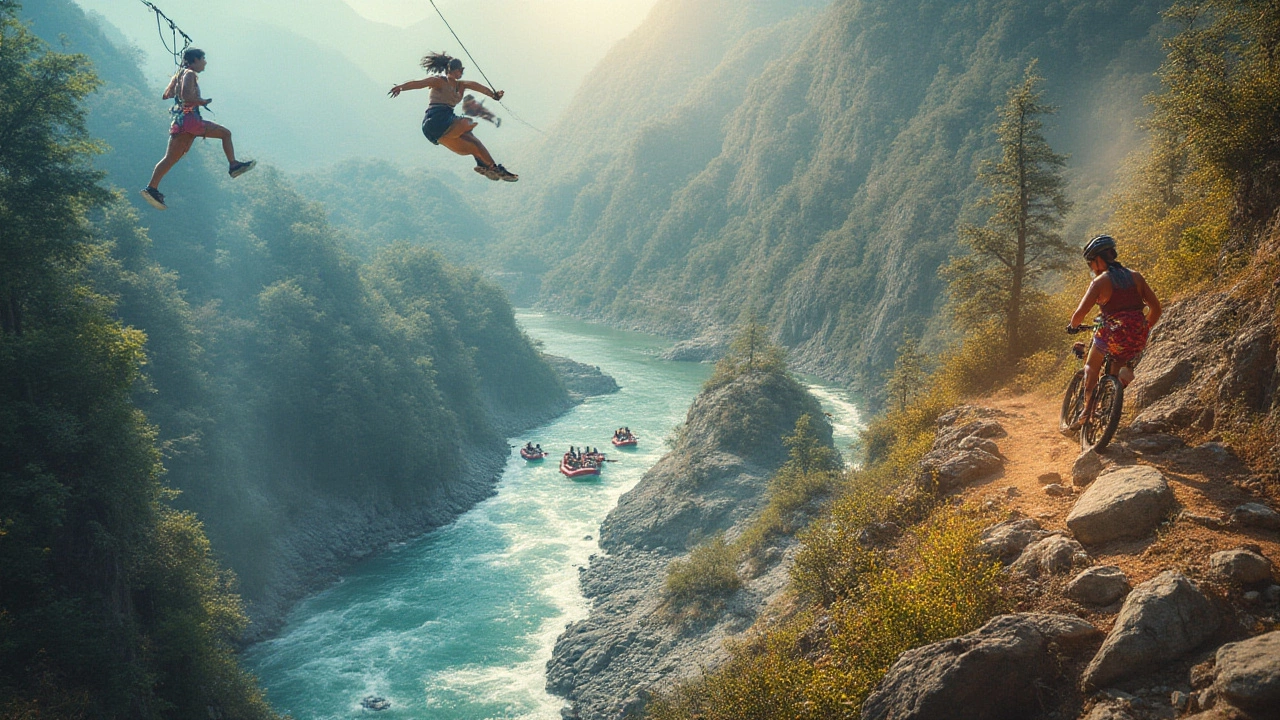Ever seen someone ride a bike off a cliff—on purpose? Or glide across impossible waves in the middle of a storm? The way people chase adrenaline these days feels like it's straight out of a movie. But here’s something wild: extreme sports aren’t just for daredevils with a death wish. They’ve become a sort of gateway to freedom, confidence, and—for a lot of folks—sheer happiness. There's this unspoken bond among people who jump out of planes or cling to rock faces miles above the ground. But here’s the real question: with so many wild choices, what is the best extreme sport? Ask ten thrill-seekers and you’ll get ten different answers, but let’s finally unravel what makes one sport rise above the rest.
Defining Extreme Sports: Pushing the Limits
“Extreme sport” doesn’t just mean risky or dangerous. At its heart, it’s about adventure, the edge of human ability, testing limits with nature or gravity itself as your rival. It’s more than just a hard workout—it’s a balance of skill, guts, and a taste for the unexpected. The International Olympic Committee defines extreme sports as “competitive activities perceived as involving a high degree of risk,” but anyone who’s ever watched skateboarders pull tricks on skyscraper railings or climbers free-soloing can see that definitions only go so far.
From skydiving to wingsuit flying, base jumping, BMX, parkour, street luge, whitewater rafting, downhill mountain biking, freestyle motocross, and big wave surfing, there are hundreds of ways to experience pure adrenaline. Some, like base jumping, see less than 4,000 participants worldwide, but draw media attention when the risks turn fatal. Others, like skateboarding and BMX, have cultivated huge communities—they even made it into the Tokyo Olympics in 2021. So, popularity doesn’t always mean something is more extreme, but community often means bigger innovation, better gear, and more access for beginners.
Gear is another cornerstone of these sports. Think about the improvement in parachutes for skydivers, or the carbon fiber boards now used by surfers. Each material upgrade pushes the sport further. So much of the thrill comes from a mix of mental challenge, environmental unpredictability, and technical finesse. Maybe a rock climber will spend half a year mastering finger strength for a single boulder, while a parkour athlete dedicates months to learning how to land safely on concrete. It’s not just about recklessness; in fact, most extreme athletes are meticulous with planning and preparation to balance the thrill with safety.
Interestingly, most extreme sports began on the fringes and worked their way into the mainstream. Take snowboarding—it was once outlawed at ski resorts until the 1980s, and now it’s a Winter Olympic staple. The culture of pushing against “normal” rules is baked right in. Each sport also comes with its own attitude. Surfers call it “stoke.” Skydivers just call it “the rush,” and climbers talk about “flow.” The drive is universal: regular sports aren’t enough. These athletes want that mixture of freedom, fear, and focus.
If you’re considering extreme sports yourself, ask: are you in it for the community, the personal challenge, or the out-there locations? Each sport has a different draw. And the best part? The learning never stops. Every session brings a chance for a new thrill—and a new scare—no matter how much you prepare.
The Top Contenders: Which Sports Make the Cut?
Ready to see which activities actually top the list? Here are a few that always steal the spotlight when people debate the best extreme sport:
- Skydiving: There’s nothing like jumping out of a plane at 12,000 feet. Every year, close to 3.5 million people jump…and feel that rush of freefall. While it sounds crazy, skydiving is statistically safer than driving for people who jump with a certified instructor. But that sound of wind rushing past your ears? That’s irreplaceable.
- Big Wave Surfing: If you think regular surfing looks tough, imagine catching a wall of water the size of a four-story building. The waves at places like Nazaré, Portugal can top 80 feet, and surfers train years just to paddle out. The danger is real—big wave surfers face hold-downs lasting minutes, and sharks are sometimes the least of their worries.
- Wingsuit Flying: This one looks superhuman. Wearing a suit that lets you glide like a flying squirrel, you leap off cliffs or out of helicopters and fall at 120 mph, steering with your body. Each flight lasts less than two minutes, but the adrenaline is next-level. The catch? Mistakes at speed usually mean game over, so this one stays reserved for experts only.
- Downhill Mountain Biking: High speeds, unpredictable terrain, and gravity pulling you around every hairpin turn make this sport a favorite for those who love staying grounded—sort of. The most famous races, like the Red Bull Rampage in Utah, feel like video games brought to life. Bikers train for years in handling jumps, drops, and sudden changes in weather or surface.
- Rock Climbing (especially free solo and alpine): Ever seen "Free Solo"? Watching Alex Honnold climb 3,000-foot vertical walls with no rope set off a rush for people worldwide to try climbing. There are indoor gyms for beginners, but the true heart of the sport is outside. Every hold, every foot slip, and every storm can turn things upside down.
- BASE Jumping: Imagine skydiving, but from buildings, antennas, or cliffs—and with a fraction of the planning time. Jumps rarely last more than five seconds, but that makes it all the more intense. BASE jumpers are a rare breed, and for good reason: this sport ranks among the most lethal of them all.
So, what actually makes a sport “the best” in people’s eyes? It usually comes down to a combination of difficulty, danger, skill, personal challenge, and—let’s be real—a dose of cool factor. Social media throws fuel on every debate. Someone lands a new trick or surfs an impossible wave, and overnight, thousands more want to give it a shot. Each year seems to shatter the last’s records. The difference between spectator and participant is shrinking; GoPros and drones mean everyone can share the wild ride, and newcomers are always searching for the “next big thing.”
One eye-popping statistic: Red Bull’s Stratos jump in 2012, when Felix Baumgartner leapt from space, racked up over 8 million live viewers, showing how much the world cares about mind-bending feats. That event set the standard for what’s possible. Since then, sports brands keep finding new ways to amp up safety and push limits. Don’t be surprised if the next “best” sport hasn’t even been invented yet.

Behind the Rush: Safety, Mindset, and Myths
Most people shy away from extreme sports because of the fear factor. But here’s the twist: the best athletes are usually the most risk-aware players out there. There’s a careful science to the madness. Skydivers, for example, inspect their gear carefully before every jump, use backup parachutes, watch the weather, and constantly practice emergency drills. The U.S. Parachute Association even claims that jumping with a licensed instructor gives you a 1-in-1.5 million chance of dying, a risk much lower than taking a long road trip during a holiday weekend. Yet, the myth of reckless behavior persists.
Mindset is everything. Athletes talk about “risk compensation” almost as if it’s a sixth sense—they plan for every variable but know that nature can still play tricks on the best-prepared. Mountain bikers test every turn before a downhill race, and climbers double-check knots and anchor points. There’s a heavy respect for the power of the environment. A sudden wind gust, a rogue wave, or slick rock can turn things dangerous. Top athletes never let ego cloud their judgment; the ones who do seldom stay in the sport for long.
It isn’t just about the adrenaline, either. Studies at the University of Exeter found that extreme sports can boost problem-solving, build mental resilience, and even reduce anxiety when practiced safely. Some therapists now recommend adventure sports for folks dealing with stress or burnout. The hyper-focus you need, plus the sense of achievement afterward, often do more for mental health than any amount of scrolling on your phone ever could.
But there’s a darker side. Extreme sports are home to legends who paid the ultimate price—Shane McConkey in ski BASE jumping, or Dan Osman in speed climbing. These stories echo in every training session. That’s why beginners are always urged to seek guidance, take courses, invest in the right gear, and never skip steps just to impress others. There’s no shortcut to confidence; hours and hours of preparation, both physical and mental, are what make the difference between a “close call” story and a newspaper headline.
If you’re tempted to try something new, beginner courses are available in almost every corner of the world. Certified instructors, starter clinics, and simulator setups take the edge off risk. While some sports (like wingsuit flying or big wave surfing) really do need years of practice and mentorship, others—like indoor climbing, skateboarding, and basic skydiving—offer quick, safe introductions. Starting slow is the fastest way to go far here.
So, Which is the Best Extreme Sport?
If you want a boring, black-and-white answer, sorry—you won’t find it here. The best extreme sport? It all depends on what you crave: air, water, land, or a blend of all three. Skydiving gives you that supernatural freefall, surfing delivers that primal dance with the ocean, and mountain biking puts you at the mercy of mud, trees, and terrain. Every sport offers a mix of thrill, skill-building, and the tightest communities you’ll find anywhere.
But one thing stands out: the “best” sport is the one that speaks to your spirit and gets you hooked, time after time, no matter how tough it gets. Talk to veteran extreme athletes and they’ll mention the never-ending learning curve—the fact that you never truly master what nature throws at you. That sense of humility meets thrill is what keeps people coming back, year after year. Sure, some chase world records or viral fame, but most just want another taste of that indescribable rush.
Here are a few tips if you want to get started:
- Pick a sport that matches your natural comfort zone—if you can’t stand heights, maybe surfing beats climbing.
- Find mentors or trusted instructors. The best lessons come from those who’ve survived the wildest stories.
- Don’t cheap out on gear. Safety should never be an afterthought; even experienced athletes splurge on helmets and certifications.
- Start small. Master fundamentals before you try to set any new records or film your highlight reel.
- Stay humble, learn from every fall, and always remember: the mountain (or ocean, or sky) doesn’t care how tough you think you are.
If you want to argue about “the best” extreme sport forever, you won’t be alone. But ask anyone who’s felt that edge-of-your-seat excitement: there’s nothing else like it. It’ll keep pulling you back—one breathtaking, unforgettable adventure at a time.
